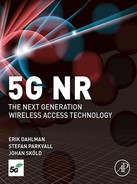Book Description
5G NR: The Next Generation Wireless Access Technology follows the authors' highly celebrated books on 3G and 4G by providing a new level of insight into 5G NR. After an initial discussion of the background to 5G, including requirements, spectrum aspects and the standardization timeline, all technology features of the first phase of NR are described in detail.
Included is a detailed description of the NR physical-layer structure and higher-layer protocols, RF and spectrum aspects and co-existence and interworking with LTE. The book provides a good understanding of NR and the different NR technology components, giving insight into why a certain solution was selected.
Content includes:
- Key radio-related requirements of NR, design principles, technical features
- Details of basic NR transmission structure, showing where it has been inherited from LTE and where it deviates from it, and the reasons why
- NR Multi-antenna transmission functionality
- Detailed description of the signals and functionality of the initial NR access, including signals for synchronization and system information, random access and paging
- LTE/NR co-existence in the same spectrum, the benefits of their interworking as one system
- The different aspects of mobility in NR RF requirements for NR will be described both for BS and UE, both for the legacy bands and for the new mm-wave bands
- Gives a concise and accessible explanation of the underlying technology and standards for 5G NR radio-access technology
- Provides detailed description of the NR physical-layer structure and higher-layer protocols, RF and spectrum aspects and co-existence and interworking with LTE
- Gives insight not only into the details of the NR specification but also an understanding of why certain solutions look like they do
